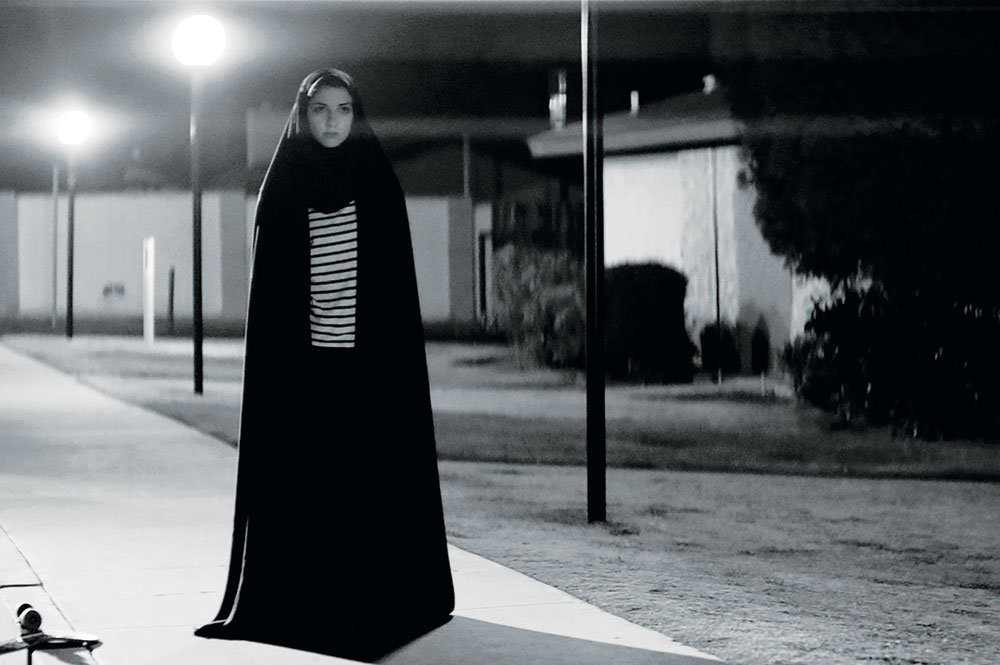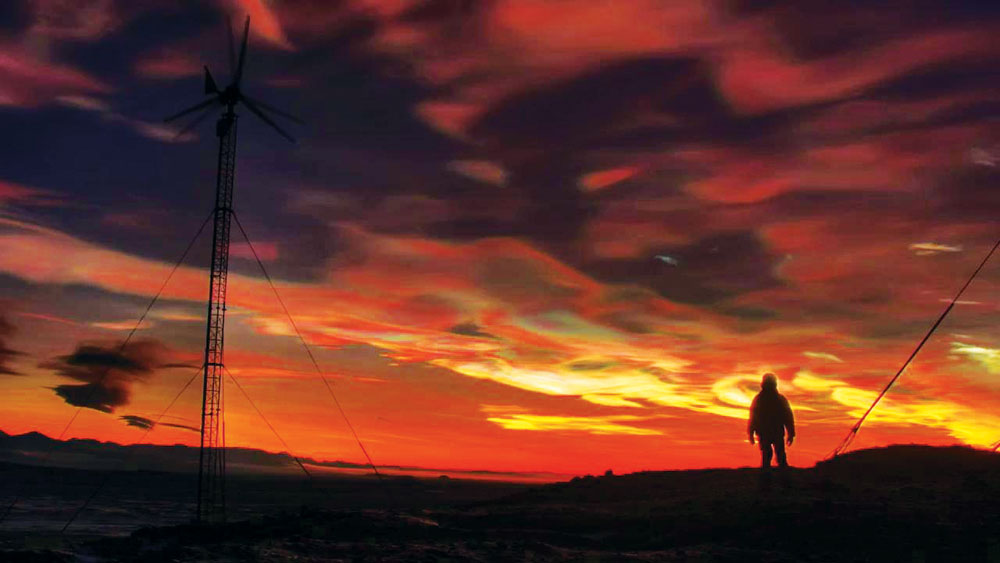 Each month, the Indie Prof reviews a current film in the theater and a second film that is available at Redbox or VOD. This month, however, the reviews are both available on demand. The supply of newer films did not live up to the Prof’s scrutiny. Follow “Indie Prof” on Facebook for updates about film events and more reviews.
Each month, the Indie Prof reviews a current film in the theater and a second film that is available at Redbox or VOD. This month, however, the reviews are both available on demand. The supply of newer films did not live up to the Prof’s scrutiny. Follow “Indie Prof” on Facebook for updates about film events and more reviews.
A Girl Walks Home Alone at Night (2014)

Scene from A Girl Walks Home at Night
This is an American-made Iranian-ish film about a female vampire stalking the Iranian town of Bad City, spoken completely in Persian and shot in a beautiful black and white. It is an intriguing mix that works: New director Ana Lily Amirpour fashions a smart, interesting, sexy, and surprising first-time feature, one that impresses and shows great promise for her future. The film is another in a line of excellent recent art-house horror films, such as Only Lovers Left Alive or Let the Right One In. Amirpour’s film matches up to those films, and the aesthetic and pacing are very much akin to Jim Jarmusch, the king of the art-house independent films.
The story is about a young female vampire, “The Girl” who is stalking the town and picking off men. At times, she is a moody, brooding teenager, at home with her pop culture iconography; other times she is a ruthless, stalking, veiled killer. Played by second-generation Iranian-American actress Sheila Vand, she is at times shy and young, and at other points old and omnipotent. Her love interest is sparked by the handsome young leading man, Arash (Arash Marandi), a James Dean-type young man whose heroin-addicted father seems to be the only family in the film. They are both great, with subtle performances by these young actors, but the real star is behind the camera.
The atmosphere and mood are established early on: a seemingly lawless world where oil derricks pump away in the background, bodies lay untouched in fields, and the town is borderline deserted. Amirpour has counted Sergio Leone as one of her influences, and the opening of her film can be traced back to Leone’s own A Fistful of Dollars. That same sense of a fallen, diseased world permeates the film and seeps through every aspect of the setting.
Aside from the excellent cinematography and superb acting, an autobiographical subtext is revealed in the storyline. As a young Iranian-American growing up in the U.S., Amirpour must have experienced her fair share of teen angst. The teenage years can be difficult enough without a feeling of being “The Other.” Lensed through this context, the character’s name “The Girl” is quite apt. As “The Girl” feasts on predatory men in the film, we can sense some catharsis going on. Overall the film succeeds on all levels, including the aesthetic and the thematic.
(Anyone else have a young son/daughter and not looking forward to those teenage years?)
You will enjoy this film if you liked Only Lovers Left Alive, Let the Right One In, and/or Persepolis. Available at all VOD outlets.
Antarctica: A Year on Ice (2013)

Scene from Antarctica: A Year on Ice
“Nature documentaries” take on a negative connotation—we immediately entertain thoughts of long stretches of landscape, animals running wildly, and “the voice of God” narration from a droning professional that always seems completely disconnected from the subject. And then there is Antarctica: A Year on Ice, shot over the course of 10 years by first-time documentarian Anthony Powell. The film is stunningly beautiful, fascinating, and surprisingly human in such a desolate setting. We get to see and feel what it’s like to be there through the endless summer days and the darkness of winter. We feel the loneliness and desolation, but we also understand the lure of the place, the natural beauty, and the effects of living in such a world.
Much of the film is shot in time-lapse in extremely difficult conditions: sometimes in -60 degree temperatures where the LCD display on the camera would freeze. Many times, Powell did not know what his footage looked like. But the payoff is stunning: the shots of the Southern Lights—ethereal, otherworldly, and even psychedelic, are the highlights of the film. But there is also the stark reality: snow/ice storms so bad that the doors become blocked, the icy world around the camps that seeps in through the cracks, and the frequently changing weather that can be deadly with one bad choice. But the people still live on.
And at its heart, this is really a film about people: their decisions to go/stay, how their lives move along (or don’t) in such a place, and the interactions that keep them going throughout the year. As we watch, we are just as fascinated by the little moments people miss: “a shower,” “the sound of falling rain,” or “cauliflower” as we are by the stunning landscapes. The moments of ordinary life, both present and past for the residents, are captivating, and round out this gem of a film.
You will like this film if you enjoyed Chasing Ice, The Cove, and/or The End of the Line. Available at all VOD outlets.
Vincent Piturro, Ph.D., teaches Cinema Studies at Metropolitan State University of Denver. He can be reached at vpiturro@msudenver.edu.




0 Comments